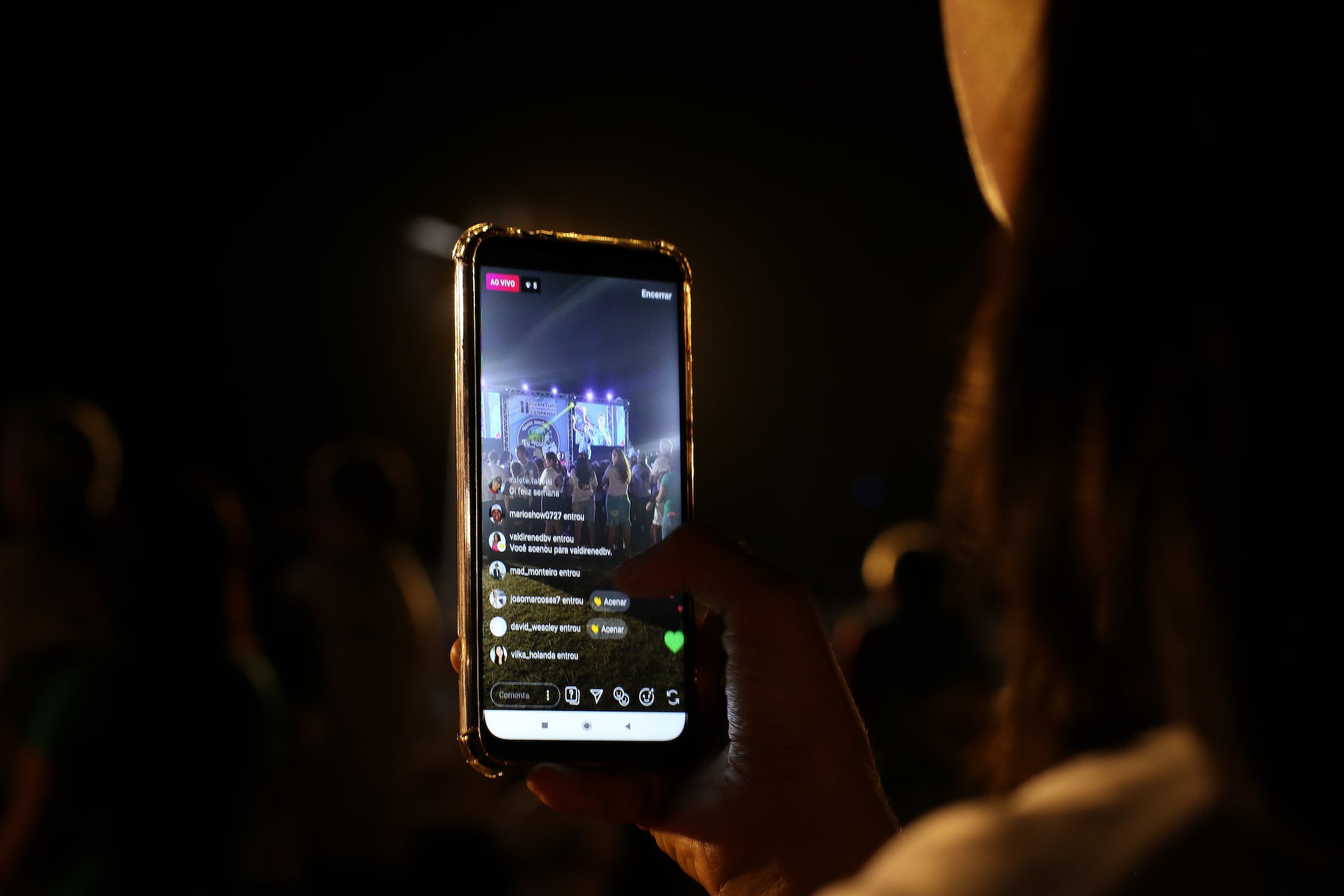Live Streaming
When a video is shown in real time and sent over the internet without first being recorded and stored, is called live streaming. To date, television broadcasts, video game streams, and social media video can all be live-streamed. For the technical requirements for live streaming, you’ll need a camera, mic or microphone, lighting, and a stable internet connection. You’ll also need to get your (digital) hands on some live streaming software.
One can strengthen his connection with the audience during live streaming, whether you’re a business, an influencer, a gamer, or a content creator. It offers a great way to take your brand to the next level.
Through Live Streaming you can:
Expand your reach: Connect with audience members interested in your event but can’t attend it live. You have the potential to connect with way more people virtually than could ever attend your event in person. The live streaming of events is a great way to expand your reach to the masses.
Increase participation: Not everyone who wants to attend your event in person will be able to due to health reasons, time constraints, and financial concerns. With a live stream, many of those barriers disappear, allowing you to increase participation in your events. The connectivity enhances even more if you place a Q&A or interactive session within your stream.
Learn about your audience: When you live stream your event with a professional video hosting service that provides analytics, you can learn about your audience’s location and how they engage with your content in real time. That can allow you to create more customized events in the future with live event streaming analytics.
Motivate your in-person audience: If you have ever seen the crowd camera at a sports event, you know how people love to be on camera. When you live stream your event, you give your in-person audience a chance to be on camera. Use your live stream to get more in-person audience engagement.
Include your virtual audience: Create engagement with your virtual audience. Ask them to tweet or respond to questions during the event to create more engagement.
Share the moment: Event live streaming is a great way to share special moments with viewers worldwide. Don’t limit who can attend a graduation ceremony, product launch, or other events by keeping them in-person only; make all special moments virtually accessible.
Best Practices When Using Video Cameras for Live Streaming
- Know the goal of your video. Whether you’re promoting a product, holding a Q&A around a certain topic, or just keeping your audience engaged, you need to create an outline for your live stream. This doesn’t mean that you read from a script, but it will help you stay on track and keep your video well organized. If your video mainly consists of you silently reading the comments, trying to get equipment to work, or thinking-out-loud about what to talk about, then your audience will leave and be less likely to check out your next video.
- Promote your live stream in advance. Promote the time, topic, and any call to action or (CTA ) or giveaway that you’ll be discussing. This is your opportunity to make your case for why people should tune in.
- Have a partner behind the camera. The role of the person behind the camera should be to monitor the feed, keep the on-camera talent on schedule, and review the comments for questions. Their responsibility is to keep the entire video as engaging and as seamless as possible.
- Plan for engagement. While touched upon in the previous bullet, it’s worth stating again. Live video is perfect for audience engagement. You don’t have to call out everything everyone says, but rewarding a handful of ‘on topic’ questions or comments with on-air acknowledgment will go a long way in the eyes of all of your viewers.
- Have a plan for how you’re going to begin. If your plan is asking someone “are we live?”, that’s not a great plan. Instead, begin with an icebreaker to get your audience engaged. It could be as simple as asking them where they’re from and commenting on a few of the locations or asking where they’re joining you from. This is a great way to fill some time and allow your audience to get their notifications and join your video, while also engaging with viewers.
- Consider a consistent schedule. We say consider here because if you don’t have anything worth talking about, don’t go live. However, if you’re the type of business that is able to share compelling behind-the-scenes content, tips, or able to hold industry/product Q&A sessions, then it’s worth letting your audience know when they can expect you to go live again. This trains your audience to anticipate your content and gives them an opportunity to prep any questions.
- Have the right equipment. A dimly lit video with horrible sound is not a good look for your brand. Not only will your audience be less likely to spend time watching, but it leaves an impression that your product, service, or team are of a lesser quality and possibly not worth their time or money. The good news is that it’s not expensive to have a decent set-up.
- After having the right equipment, consider bandwidth. Bandwidth, or streaming data, is a critical issue for the success of any live video stream. Internet speeds are measured using two different numbers: upload, and download. Upload refers to how fast you can send data out to the broader internet, and that’s the number on which we’ll focus here.
If you don’t have sufficient upload speed at your broadcast location, your viewers might experience playback issues. That can ruin a broadcast, so you want to ensure you have plenty of bandwidth.
Top Social Streaming Platforms
Facebook live
Overview and Company History:
Regarding video hosting, Facebook offers both “Live” and “Watch,” which allows businesses and organizations to host on-demand content or broadcast live content.
Live streams can be hosted on personal profiles, pages, and groups, but on-demand “Facebook Watch” videos can only be published on Facebook Pages.
Facebook Live is commonly used by businesses and organizations that are just dipping their toes in live broadcasting. Since it is a free platform, Facebook Live poses many challenges related to video ownership, time limits on videos, monetization, and more.
Aside from those few technical restrictions, live streaming with Facebook Live is valuable for connecting with existing audiences.
Basic Functionality:
It is common for broadcasters who use premium streaming solutions to connect their accounts to multicast on Facebook and their websites. That allows users to tap into their existing Facebook audiences while accessing the professional tools of a hosting solution.
Key Features:
Facebook is a social media platform with tools for uploading and sharing videos to online communities.
Detailed Features:
Facebook Live
Facebook Watch
Facebook Groups
Facebook Pages
Easy video sharing
Live commenting and reacting
Paid ads
Some tools for business use
Pros:
The app is free
Viewers are familiar with the platform
Live chat promotes engagement
Taps into existing following
Cons:
No monetization options
Time limits on live videos
Cannot remove Facebook Live branding
Upload Guidelines and Specs:
Minimum dimension: 720p (1280×720)
Maximum dimension: 1080p (1920×1080)
Aspect ratio: 16:9, 9:16, 2:3, 4:5, 1:1
Max file size: 4 GB
Max video length: 90 minutes
Total file storage: No storage limit
Compatible video formats: MP4, MOV, MPEG4, AVI, 3GPP, WMV, FLV, MKV
Facebook Live works best when integrated with a professional live streaming platform that allows for simultaneous casting to multiple sites. It can allow you to connect to your already-developed Facebook audience.
Overview and Company History:
Instagram is a popular social media app with various video-sharing features. If you want to broadcast live videos with high production values, the app isn’t for you, but it is great to share pre-recorded videos.
Basic Functionality:
Both consumers and businesses upload small, shareable clips to the platform to share with followers. Businesses often use Instagram Live to tease the content on their site or app. They add CTAs that lead users to their websites with products or longer videos. Instagram Live is popular for eCommerce businesses and offers sellers the ability to include shoppable and product links in their stories, reels, and live broadcasts.
Key Features:
Instagram is a social media platform for sharing pictures and videos. Basically, Instagram Live is a social network that allows you to live stream music and videos. If you want a dedicated streaming service, it’s better to look at other platforms.
Detailed Features:
Live streaming on stories
Video and photo sharing
Direct messaging tools (which can be used to share posts and interact)
Minimal privacy controls
Some business tools
Pros:
Free to download and use
Popular among most age groups
Easy to navigate
Uploading and sharing is almost instantaneous
Some business tools
Supports streaming
Live shopping
Cons:
No monetization features
Poor privacy tools
Limited streaming hours
Minimal live streaming features
You can be temporarily blocked from live streaming if you mistakenly violate Community guidelines
Stream can be taken down abruptly if the platform hears popular music in the background
Upload Guidelines and Specs:
Minimum dimension: 864 x 1080 (recommended)
Maximum dimension: 864 x 1080 (recommended)
Aspect ratio: 9:16, 4:5
Max file size: 15 MB
Max video length: Depends on which feature you use
Total file storage: Unlimited
Compatible video formats: MP4
Instagram is great for video sharing; however, you are going to want to back that up with a professional live streaming service.
Alt-text: ( tiktok)
Tiktok
Overview and Company History:
TikTok is a live video streaming app that is still relatively new to the scene, and its algorithm is geared toward growth. That means it’s relatively easy to go viral and build a following on this app, even if it’s by mistake.
TikTok is a social media platform through and through, but when used strategically, businesses can use it to lead viewers to their websites for their intended conversion.
Basic Functionality:
Please note that most TikTok users are Gen Zers, meaning most viewers on the platform are around the age of 25 and younger. This option is best suited for businesses with an audience in that age group.
Key Features:
TikTok has some live streaming tools, but the platform is primarily used for sharing short video clips.
Detailed Features:
Highly controlled live streaming tools
15-180 second video sharing
“Dueting” tool, which allows users to use parts of existing videos for their own
“For You Page” that generates content based on viewers’ interests
Very young users
Pros:
Free to download and use
The algorithm makes it easy to go viral
Suitable for quick growth
Generates a “For You Page” based on viewer behavior
Because they limit who can go live, when you do get 1000+ followers, you’re able to stand out with live videos
Cons:
Extremely limited monetization options
A 180-second video length limit
Cannot remove TikTok branding
Ongoing issues with data privacy
Not everyone can go live. You need 1,000+ followers.
Upload Guidelines and Specs:
Minimum dimension: 1080 x 1920
Maximum dimension: 1080 x 1920
Aspect ratio: 9:16
Max file size: 287.6 MB on iOS and 72 MB on Android
Max video length: 3 minutes
Total file storage: No storage limit
Compatible video formats: MP4, MOV
TikTok supports 15 seconds, 60 seconds, or 3-minute videos. This isn’t long enough for a live stream event but it can be a way to connect and grow your audience with short soundbites.
Youtube live
Overview and Company History:
YouTube was one of the first social broadcasting sites to make online video streaming popular, and it has grown exponentially in the past decade. This Google-owned website is designed for consumers, but many businesses use it while they are getting into broadcasting.
YouTube is not the best platform for live video streaming hosting since the site has strict limitations on monetization and other professional tools. Additionally, YouTube requires that broadcasters give up partial ownership of their content when they upload it to the platform. It is a live stream service that your business can use, but it has major limitations.
Basic Functionality:
Youtube Live is a free B2C video streaming platform designed for users with little to no prior broadcasting experience.
Key Features:
YouTube is primarily a consumer-grade video sharing platform. It supports both VOD and live streaming, but the most popular content on the platform is on-demand videos.
Detailed Features:
Ad-based monetization is limited to users with large followings and watch times
No notable security features
Popular among consumers
Powered by Google
Easy to share videos
Videos can be embedded in other websites
No white-label capabilities
Pros:
Free to use
YouTube is a household name, so viewers are comfortable using it
Easy to use (for both viewers and broadcasters)
Easy to embed video player
Live and VOD hosting
Cons:
Cannot remove YouTube’s branding
Limitations on live streaming
Strict restrictions on content. For example, if there’s a popular song playing in the background, your video can be abruptly taken down for copyright reasons.
YouTube owns partial rights to your content. For example, if you rely on in-video sponsorships, you may be forced to start giving a cut of your revenue to Youtube in the future.
Distracting third party ads and branding
YouTube will suggest the videos of competitors off to the side, which can drive away potential fans
Upload Guidelines and Specs:
Minimum dimension: 240p (426 x 240)
Maximum dimension: 4K (3840 x 2160)
Aspect ratio: 16:9 (adds padding to videos with other aspect ratios)
Max file size: 128 GB
Max video length: 12 hours
Total file storage: No storage limit
Compatible video formats: MP4, MOV, MPEG4, FLV, AVI, Web M, WMV, MPEG-PS, 3GPP
YouTube is a free live streaming platform,that free tag comes with a cost, as you don’t have the complete control over your content that a professional-grade live streaming platform can offer your business.
Tips To Boost Audience Engagement During Live Streaming
1. Choose the Right Live Streaming Platform
Aside from the platform mentioned above (facebook live, Instagram, Tiktok, and youtube live there are other professional live streaming platform such as Restream, Brightcove, or Dacast. These platforms provide you white-label custom branding, SEO, and security features, and more. Another significant advantage is that many of them allow you to stream on multiple social platforms simultaneously.
2. Create a Live Streaming Schedule and Stick To It
To make the best of your live streams, you need to reach a new audience and engage them regularly.
3. Make Your Live Stream Engaging Through Questions and Polls
One of the best ways to engage your audience during a live stream is to ask them questions and use surveys/polls.
4. Analyze Your Live Stream To Optimize It
Once you are done with your live stream, it is time to analyze its performance. Most live-streaming platforms, have analytics features built within them.
With a variety of streaming platform professional and social it is now easy to broadcast live video and reach a large pool of your audience
There’s always more to learn and improvements that can be made. As always, we hope that this article has introduced you to some key elements for a successful live video stream.







